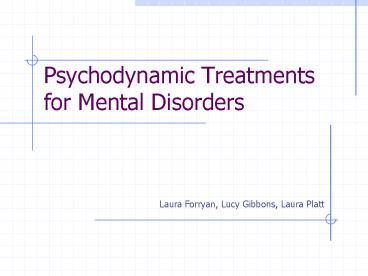Psychodynamic Treatments for Mental Disorders - PowerPoint PPT Presentation
1 / 14
Title:
Psychodynamic Treatments for Mental Disorders
Description:
The Psychodynamic approach focuses on the unconscious influence of events during ... analyst is to help the client unravel the latent content of their dreams from ... – PowerPoint PPT presentation
Number of Views:49
Avg rating:3.0/5.0
Title: Psychodynamic Treatments for Mental Disorders
1
Psychodynamic Treatments for Mental Disorders
Laura Forryan, Lucy Gibbons, Laura Platt
2
Introduction
- The Psychodynamic approach focuses on the
unconscious influence of events during childhood.
- Freud is a key psychologist in this approach,
believing that mental energy can be discharged or
transformed, but not destroyed.
3
Treatment Psychoanalysis
- The aim of psychodynamic therapy is to help the
individual cope better with inner emotional
conflicts that are causing disturbance. - This helps them gain insight or conscious
awareness of the repressed conflicts. - This is a form of catharsis (releasing the power
they exert over behaviour).
4
Free Association
- Client reclines on couch with the therapist out
of sight and is allowed the free flow of
feelings/thoughts/images. As these come to mind,
clients express them in words. - The analyst must listen, suspending their own
values and judgements and interrupting
occasionally to ask client to reflect upon
significance of associations which should arise
from internal dynamic conflict.
5
Word Association
- Client is read a list of words one at a time and
asked to reply with whatever comes instantly to
mind. - The analyst pays particular attention to unusual
responses, hesitations and mental blanks, which
may indicate repression.
6
Dream Analysis
- The role of the analyst is to help the client
unravel the latent content of their dreams from
the manifest content e.g. Symbols. - Dreams are interpreted as wish fulfilment,
usually of a sexual or aggressive nature.
7
Transference
- This occurs when client redirects feelings
towards the therapist that are unconsciously
directed towards a significant person in their
life (usually a parent) but which have been
blocked from the conscious mind. - It is important because it indicates that
repressed conflict Is coming very close to
conscious awareness. - It must occur naturally and the therapist must
not encourage or prevent it. The aim is to
identify the source of the transference and the
circumstances surrounding the repression.
8
Projective Tests
- A client is asked to describe what they see in an
ink blot or to tell a story around the picture.
These are used as tools to uncover recurrent
themes that may reveal the unconscious needs and
motives of the person.
9
Freudian Slips
- Freud saw Freudian slips as a route to the
unconscious. Errors and mistakes we make in
everyday life are unconscious thoughts finding
their way into consciousness. - Slips of the tongue can reveal repressed
anxieties or desires that need to be dealt with
consciously.
10
Evaluation of Psychoanalysis
- Psychodynamic therapy is generally conducted over
a number of years, which makes it expensive, and
this has restricted its availability. - It is generally regarded as appropriate treatment
for anxiety disorders, depression and eating
disorders.
11
Evaluation of Psychoanalysis
- Comer (1995) cites the American Psychiatric
Associations concerns over transference as a
treatment for depression as patients have a
tendency towards extreme dependency on important
people in their lives. - He also points out that Psychoanalysis may be
detrimental to the treatment of
obsessive-compulsive disorder as free association
may inadvertently increase the persons tendency
to ruminate and overinterpret.
12
Evaluation of Psychoanalysis
- Boker (1992) points out that psychoanalysis
wasnt very useful to schizophrenics as the
treatment requires insight, but with the use of
phenothiazines, psychoanalysis can be used to a
greater extent on these patients. - Eysenck (1952) claimed that psychoanalysis does
not work.He reviewed two outcome studies which
showed that 66 of the control group improved
spontaneously, whereas only 44 of psychoanalysis
patients improved. - BUT Bergin (1971) said this study was unreliable
as the patients in the control group were
hospitalised and the other group were treated by
their GPs. He also found that by selecting other
outcome criteria, psychoanalysis improvement
increased to 83 and the control decreased to 30.
13
Evaluation of Psychoanalysis
- Thase et al (1997) looked at 6 studies with 595
patients diagnosed with major depressive
disorder. They examined the effectiveness of
psychotherapy combined with antidepressants
compared with psychotherapy alone over a twelve
week period. It showed that with less sever
patients, there was no significant difference
between medication and no medication (37 vs 48)
but with more severe patients, it was much more
effective with treatment than without (25 vs 43)
14
Evaluation of psychoanalysis
- Mufson et al (1999) conducted a 12 week study on
48 majorly depressed adolescents between 12 and
18 years and randomly assigned to a psychotherapy
group or a control group. There was a 75
decrease in depressive symptoms and increase in
social functioning and problem solving skills
compared to 46 in the control group. - However, long-term effectiveness is not a sure
thing.































